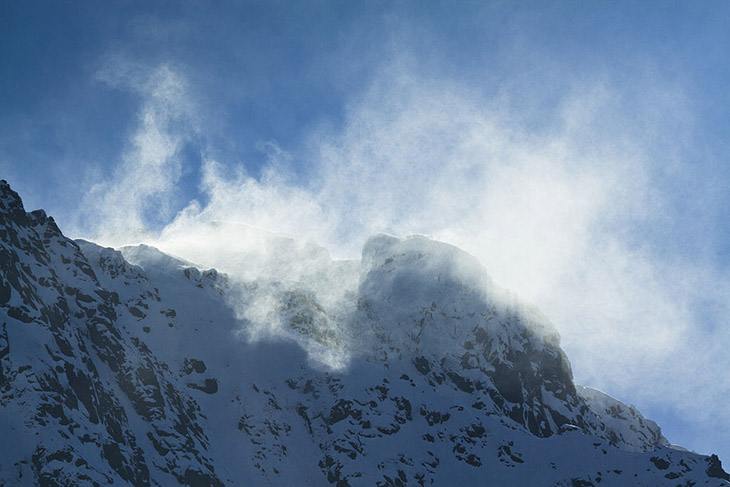Snow Blows In Fits And Starts, Only Partly Due To Wind

Wind hurls snow along the Langstrandtindan mountaintops in Lofoten, Norway.
(Inside Science) -- When snow falls to the ground, it doesn't always stay put. Wind can lift and push snow particles, like a giant breath blowing dust off a mantle. But snow doesn't blow smoothly. Scientists are finding that snow drifts in fits, and only in part because the driving air itself is unsteady. Properties of the snow, scientists think, are also playing a big role in how snow moves around the landscape.
Drifting snow matters for more than just its physics. It contributes to mass changes in rapidly transforming places like Antarctica. In alpine environments, blown snow affects the amount of meltwater that flows to thirsty communities. Precarious snow deposits can also heighten the risk of avalanches, spurring scientists to better predict drifting snow for people's safety.
Research into drifting particles traces back to North Africa's "seas of sand dunes," as Ralph A. Bagnold, a British army engineer, called them. In 1941, he published a seminal work that described how wind lifts and drags sand grains from the ground, entraining them in its wake. In the tumultuous zone above the sand surface called the boundary layer, the grains roll, creep, and bounce along the surface.
Wind whips up snow in a similar way, but the process is more complex because the properties of snow depend on an overwhelming litany of conditions. These conditions include "whether it fell throughout the night without a break, or if it fell 5 centimeters and there was wind, with another 4 centimeters much later. Or if it started to rain, and then became snow," said Philip Crivelli, a doctoral student at WSL-Institute for Snow and Avalanche Research in Davos, Switzerland. "There's so much variability."
The wind itself is also complicated. Air can move like a river, its flow a mix of smooth and turbulent. In the same way that a bumpy riverbed can affect the water coursing above, the ground interacts with wind to form eddies of swirling air. These in turn exert rapidly changing force, or shear stress, that kicks up particles from the snow surface.
To study how snow responds to the airflow, Crivelli and his colleagues cart trays of fresh-fallen snow into a controlled environment: a wind tunnel in an unheated, concrete building nestled in the Swiss Alps about a mile above sea level. The tunnel is the highest in Europe. Arranging the open trays end to end, the researchers turn on a fan to make turbulent air blow over the snow at up to 29 miles per hour.
The team uses two techniques to capture how the snow redistributes during an experiment. One method illuminates snow from the side, so that shadows of the grains fall on a screen -- similar to the way we cast shadow puppets with our hands. The result is a cross-sectional view of snow drifting in real-time.
The second approach allows researchers to "change the angle," Crivelli said, and view how the snow aggregates from above. With ceiling-mounted Microsoft Kinects -- $200 devices originally developed for hands-free gaming -- the team digitally records the blustering scene in 3D. That way they can track the snow moment by moment, and match its movement to the wind, which they measure with an ultrasonic anemometer.
Does the snow, like a graceful dance partner, move in time with the airflow and follow its lead?
Partly, said Crivelli, who presented the work at the American Physical Society's 68th Annual Meeting of the Division of Fluid Dynamics in Boston, November 22.
Some of the drifting snow behavior is "clearly forced by the [air]flow," he said. "But much of it cannot be explained just by the flow."
That's because, unlike the continuously blowing air, the snow can move intermittently: quiet for seconds, and then -- boom! -- erupting in a sudden puff of flying particles. The effects are more dramatic than what's seen with sand, the researchers said.
Now, they're investigating what about snow makes for such inconstant behavior. Patterns on the windblown surface, like ripples that suddenly break, could explain the bursts of activity, Crivelli said. He hopes X-ray images of the snow could further tease out why drifting snow is staccato.
"It's a complex problem," said Lian-Ping Wang of the University of Delaware, who chaired the session at which Crivelli presented. Because snow can collide, coagulate, and break up, predicting how it'll respond to airflow is difficult. That makes an experimental approach "particularly useful," he said. Wang studies how air moves a different kind of material -- cloud droplets -- and was not involved in the Swiss team's project. Their work, while still mostly qualitative, is "very interesting," he said.
Crivelli agrees that the variability in the snow makes the experiments challenging, but that doesn't discourage him.
Snow "really holds a great fascination for me," he said. And if he gets tired of being in the wind tunnel, he just goes for a ski. Then "everything is fine again."
Alison F. Takemura is a science writer based in Santa Cruz, CA. She tweets @AlisonTakemura.
